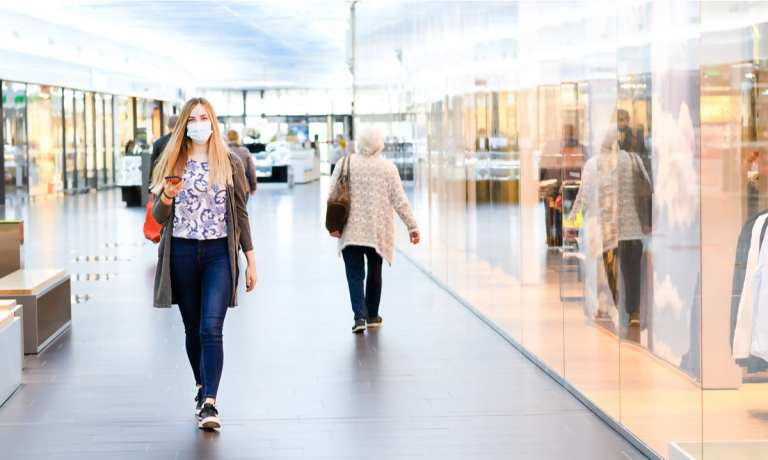
Does the end of the pandemic mean that American malls may be on the verge of renaissance as once homebound consumers find themselves eager to get out and spend again in the real world?
Recent reports in The Wall Street Journal (WSJ) certainly give that impression, citing data from “a representative sample of 52 malls in March” that showed consumers are increasingly heading out to spend at the mall once again, showing traffic up 86 percent year on year, according to mobile device location data from analytics firm Placer.ai.
Foot traffic, notably, was still down 24 percent compared to March 2019, although mall owners said a corner is being turned as consumers armed with cash are eager to get back out there again to do some spending in person, WSJ reported.
“There’s no question things are better,” Bill Taubman, president and chief operating officer of Taubman Co., told WSJ. “Sales are also better than anticipated four months ago.”
This is evident in the rising numbers. Shares of Simon Property Group are up 45 percent this year, and a rebound in the mall industry as a whole is forecast to follow in the footsteps of other pandemic bitten businesses like hotels, according to WSJ.
And the anecdotal evidence is building up as consumers are lining up in places like Brooklyn’s Kings Plaza, waiting in long lines for mall staples like Auntie Anne’s pretzels and Cinnabon rolls as they peruse the shelves.
While real recovery in any form is to be celebrated, it is at least worth wondering if we are sounding the trumpets of celebration for malls on the whole a bit early. Recovery is a wonderful thing, for example, but malls are still attempting to climb out of a rather deep hole. As of early March, reports were circulating that shopping malls saw their real estate values plummet by a staggering average of 60 percent in 2020, according to Bloomberg.
All in, some 118 retail mall properties lost $4 billion in value when compared to 2019, with reappraisals prompted by late payments, defaults or foreclosures over the last year, according to Bloomberg.
“It’s an eye-popping decline,” Gwen Roush, an analyst with DBRS Morningstar rating service, which tracks commercial real estate, told Bloomberg. “When we’re forecasting a loss on these malls, we’re even further haircutting that value.”
And while some malls have seen recovery as consumers are looking to get back out there and spend, that recovery has been far from an evenly distributed phenomenon. Some malls, mostly urban and exurban one’s catering to affluent consumers with a range of dining, shopping and entertainment options, have seen improvement as consumers have proved more interested in getting back out there. Middle-market malls serving areas with limited population growth aren’t seeing nearly so much recovery and are considered by experts likely to continue to struggle, particularly as pent-up demand subsides and heading out to the mall feels less like an exotic treat, WSJ reported.
That has left someone the nation’s largest mall retailers looking to cull their mall offering herd and leaving only properties in place that are worth saving. That will still leave about 50 percent of the country’s 1,100 indoor malls still likely to close entirely, according to Bloomberg.
Moreover, even with the mall, consumers’ newfound enthusiasm for shopping isn’t quite evenly distributed. Casual wear, accessories, jewelry and watches are all doing well, analysts said. Formal clothing and men’s suits remain sluggish, WSJ reported.
And while mall owners remain bullish that there can be recovery and even robust success still left in the mall, it won’t be the same as it was before. The changes of the last year have permanently raised the bar for mall retailers across the board, Unibail-Rodamco-Westfield Senior Vice President of Marketing Karen Strack noted in a PYMNTS panel discussion.
“Consumers want to be in the physical space,” Strack said. “They want to be able to touch and feel products and not have to lean completely on online. That said, we’re really not going to go backwards. There were a lot of silver linings with 2020, and acceleration of innovation around different touchpoints, including new offerings like curbside or buy online pickup in store, or buy now, pay later. There are all these different tools that now we can offer consumers to make it more convenient for them to shop.”
Although those new tools are becoming more prolific in the market — and will be highly useful to the high-end malls that were thriving pre-pandemic and seem to be returning to that as the pandemic dies down — for the half of malls that are still forecast to be permanently switching off the light in the near future, the pandemic recovery likely won’t be enough to power turnaround.
Which isn’t to say that the malls of the past can’t be repurposed. Healthcare providers, restaurants and educational institutions have all found all kinds of ways to repurpose the mall properties out there.
But the mall is back narrative might be a little overstated. Some malls are back — mostly the ones that weren’t in any danger of disappearing before the pandemic that are focused more on affluent consumers with a diverse line-up of services. But for the rest, it looks like the pandemic hasn’t done much to change their need to find a way to repurpose.